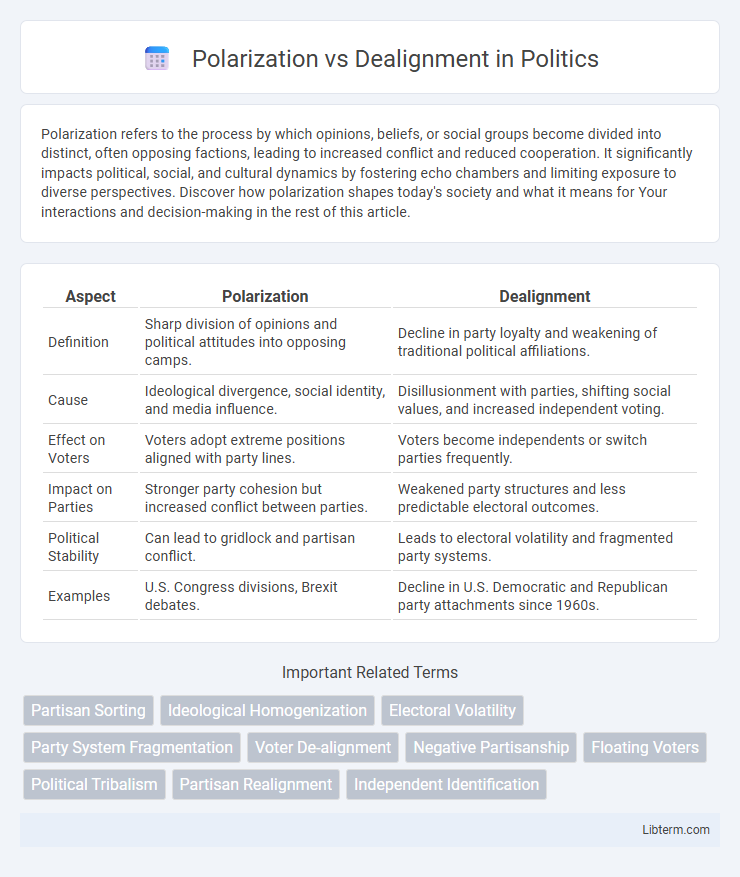Polarization refers to the process by which opinions, beliefs, or social groups become divided into distinct, often opposing factions, leading to increased conflict and reduced cooperation. It significantly impacts political, social, and cultural dynamics by fostering echo chambers and limiting exposure to diverse perspectives. Discover how polarization shapes today's society and what it means for Your interactions and decision-making in the rest of this article.
Table of Comparison
| Aspect | Polarization | Dealignment |
|---|---|---|
| Definition | Sharp division of opinions and political attitudes into opposing camps. | Decline in party loyalty and weakening of traditional political affiliations. |
| Cause | Ideological divergence, social identity, and media influence. | Disillusionment with parties, shifting social values, and increased independent voting. |
| Effect on Voters | Voters adopt extreme positions aligned with party lines. | Voters become independents or switch parties frequently. |
| Impact on Parties | Stronger party cohesion but increased conflict between parties. | Weakened party structures and less predictable electoral outcomes. |
| Political Stability | Can lead to gridlock and partisan conflict. | Leads to electoral volatility and fragmented party systems. |
| Examples | U.S. Congress divisions, Brexit debates. | Decline in U.S. Democratic and Republican party attachments since 1960s. |
Introduction to Political Polarization and Dealignment
Political polarization refers to the growing ideological divergence and partisan loyalty between opposing political groups, leading to intensified conflicts and reduced willingness to compromise. Dealignment involves the weakening of traditional party affiliations and voter loyalty, resulting in increased electoral volatility and the rise of independents or swing voters. Understanding the dynamics of polarization and dealignment is crucial for analyzing changes in voter behavior and the stability of democratic systems.
Defining Polarization: Causes and Consequences
Polarization refers to the growing ideological distance between political parties or groups, often driven by factors such as social media echo chambers, economic inequality, and partisan media. This widening divide results in increased political conflict, legislative gridlock, and reduced bipartisan cooperation. Consequences include weakened democratic institutions and diminished public trust in government entities.
Understanding Political Dealignment
Political dealignment refers to the decline in voter attachment to traditional political parties, resulting in increased electoral volatility and weakened party loyalty over time. This phenomenon contrasts with polarization, where political opinions become more extreme and parties more ideologically divided. Understanding political dealignment is crucial for analyzing shifts in voter behavior, as it highlights the rise of independent voters and the growing influence of issue-based or candidate-centered politics in contemporary democracies.
Historical Context: Shifts in Party Alignment
Historical shifts in party alignment reveal polarization as increasing ideological distance between major political parties, evident during the Civil Rights era when the Democratic and Republican parties realigned around racial and social issues. Dealignment reflects declining party loyalty and voter identification, prominent since the 1960s, driven by social changes, distrust in government, and greater political independence. These trends illustrate evolving voter behavior with polarization emphasizing sharp party divisions, while dealignment highlights fragmentation and fluidity in political affiliations.
Key Differences Between Polarization and Dealignment
Polarization refers to the growing ideological distance and division between political parties or groups, often resulting in increased partisanship and conflict. Dealignment describes a decline in voter attachment to traditional political parties, leading to more independents and fluctuating party loyalty. While polarization intensifies party loyalty and ideological coherence, dealignment weakens party structures and voter commitment.
Factors Driving Polarization in Modern Politics
Polarization in modern politics is driven by factors such as ideological sorting, where individuals increasingly align with parties that mirror their beliefs, and media fragmentation, which amplifies partisan messaging through echo chambers. Economic inequality also contributes by creating divergent social experiences that fuel political divisions. Social identity and cultural issues intensify polarization as voters prioritize group loyalty over bipartisan cooperation.
The Rise and Impact of Voter Dealignment
The rise of voter dealignment signifies a growing detachment of voters from traditional party loyalties, resulting in increased electoral volatility and unpredictability. Unlike polarization, which deepens ideological divides and strengthens party identification, dealignment reflects a fragmented electorate with more independent and issue-driven voting behavior. This shift challenges political parties to adapt strategies to engage a less loyal and more alienated voter base, impacting campaign dynamics and policy prioritization.
Effects on Elections and Governance
Polarization intensifies partisan divisions, leading to increased electoral competition and often resulting in gridlock within governance due to uncompromising party stances. Dealignment, characterized by weakening party identification, causes voter volatility and unpredictability in elections, complicating candidate strategies and coalition-building. Both phenomena challenge democratic stability by either entrenching ideological conflicts or eroding party loyalty, impacting policy continuity and government effectiveness.
Polarization and Dealignment: Global Perspectives
Polarization refers to the growing ideological division within societies, often characterized by increased political partisanship and intensified conflict between opposing groups, as seen in countries like the United States and Brazil. Dealignment describes a weakening of traditional party loyalties and voter identification, leading to higher electoral volatility and the rise of independent or non-aligned voters in nations such as the United Kingdom and Germany. Global perspectives reveal that while polarization often exacerbates social fragmentation, dealignment signals shifts in democratic engagement and challenges to established political systems worldwide.
Future Trends and Possible Solutions
Future trends indicate increasing political polarization driven by social media algorithms reinforcing echo chambers and identity-based politics, while dealignment grows as younger generations exhibit less loyalty to traditional parties. Solutions include promoting media literacy, electoral reforms such as ranked-choice voting, and fostering bipartisan dialogue to rebuild trust and encourage issue-based voting. Emphasizing policy transparency and inclusive civic education can mitigate extreme division and strengthen democratic engagement.
Polarization Infographic

 libterm.com
libterm.com